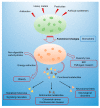Gut Microbiome Toxicity: Connecting the Environment and Gut Microbiome-Associated Diseases
- PMID: 32178396
- PMCID: PMC7151736
- DOI: 10.3390/toxics8010019
Gut Microbiome Toxicity: Connecting the Environment and Gut Microbiome-Associated Diseases
Abstract
The human gut microbiome can be easily disturbed upon exposure to a range of toxic environmental agents. Environmentally induced perturbation in the gut microbiome is strongly associated with human disease risk. Functional gut microbiome alterations that may adversely influence human health is an increasingly appreciated mechanism by which environmental chemicals exert their toxic effects. In this review, we define the functional damage driven by environmental exposure in the gut microbiome as gut microbiome toxicity. The establishment of gut microbiome toxicity links the toxic effects of various environmental agents and microbiota-associated diseases, calling for more comprehensive toxicity evaluation with extended consideration of gut microbiome toxicity.
Keywords: chemical toxicity; environment; gut microbiome.
Conflict of interest statement
The authors declare no conflicts of interest.
Figures


References
Publication types
Grants and funding
LinkOut - more resources
Full Text Sources

